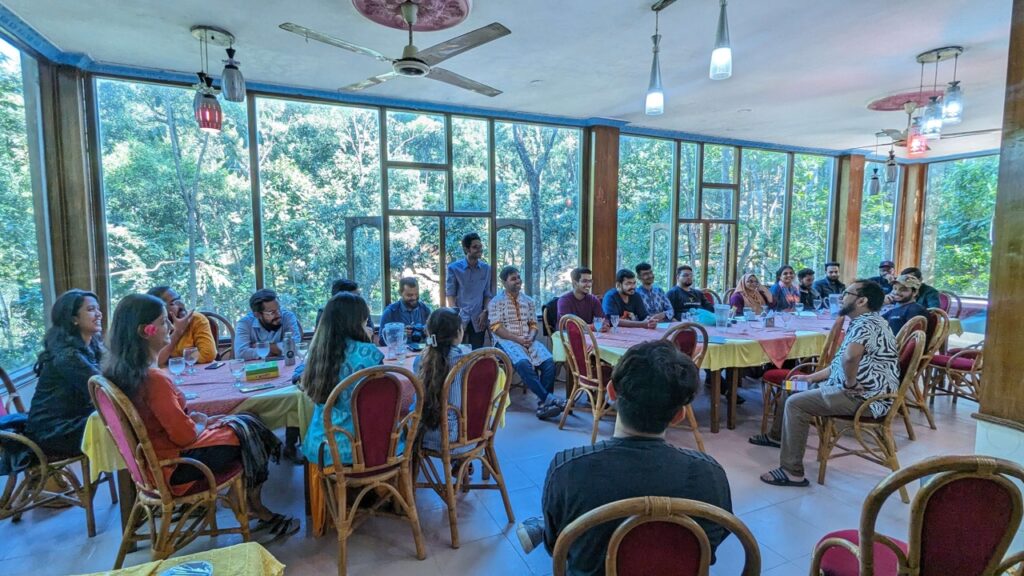Marketing 101

On Dec 1, 2023, the marketing team of authLab went on a day-long team retreat. There were a few sessions alongside some recreational activities. I spoke in the first session titled “Marketing 101”.
As my audience included both entry-level and experienced marketers, I tried to look at very fundamental aspects of marketing from a slightly different point of view. The aim was to revisit the basics of marketing and bring the audience with different levels of expertise to the same page. So here’s what I delivered –
Good morning, team awesome!
Society is filled with problems. Creating a fruitful solution is only half part of it. The rest is marketing.
What is marketing?
Marketing is a transaction. You, as a marketer, provide value, i.e. solution to a problem, to your audience. Your audience or customers provide you with value in the form of revenue.
Sometimes we hear some arguments about whether marketing is ethical or not. Just think about it. If marketing didn’t exist, people would struggle to choose the right product. Imagine going to a store and seeing all those products on shelves without any difference in packaging. And as Philip Kotler said, “Marketing is the art of helping your customer become better off”. So marketing is not only ethical, rather it’s necessary for society.
Starting from the rickshaw puller who gives us a safe ride to our office – he is also a marketer. He markets his rickshaw-pulling service, even if he doesn’t have to spare more than a few words: ‘Mama, koi jaben? Cholen.’
And that gets the job done for him. Marketing does not need hard skills to employ. It’s the skill that you acquire as you go through the process.
Well, I think sometimes that is one reason that marketers are undervalued. Don’t get me wrong, but how many times have you talked about the brilliant marketing strategies that companies like Apple adopt compared to the products they are offering?
Three stages of relationship
Marketing can be understood as a relationship between you and your customers. This relation has three stages: 1. Identify 2. Satisfy and 3. Retain.
Let me now talk a little bit about the Identify stage. This stage involves understanding who your customers are, what their needs are and how to reach them.
Now tell me how many of you exactly know your user base? Yes, they are small and medium businesses that you can easily tell from the motto of our company. But have you ever gone really deep enough to know the demography of your products’ users? And when I say demography of the users, it’s not only the data that you get to know from Google Analytics. It’s rather the niche they are operating on, the product or service they are offering, the problems that they were facing that were solved by your product.

One of the main essence of digital marketing is to communicate your marketing messages to a very specific audience. And without knowing your audience, you simply go back to traditional marketing where marketing messages are communicated to a broad audience resulting in a lower ROI.
Let’s now talk about the Satisfy stage. How do you satisfy your customers? Through creating content that provides value. In terms of creating content, I’d suggest you take inspiration from the best practices, add your own ideas and then come up with something effective and unique. Don’t limit yourselves to any boundary.
Marketing communications
Marketing communication is one of the key areas to discuss in this regard. If you look at all types of marketing communications pretty closely, you will see a clear pattern between all of them. Obviously, there is storytelling involved. But the story starts with a problem. And ends with a solution. And the solution is the product or service in discussion.
So you don’t have to be extremely innovative regarding how to create your next content. Just go as deep as you can to define the problem. Once you can tap customers’ exact pain points, you know the way to the solution.
Understanding buyer persona is also crucial in this process. Buyer persona is basically a generalized representation of an ideal customer that helps you understand current and potential customers better. Step in the shoes of an ideal user of your product and think like him. That’s never an easy task. But if you are able to do it, only then you can build effective marketing communications.
If the beginning of your marketing communication is stating customers’ pain points and the end of the story is the solution you are providing, the progress of the story must offer a Value Proposition.
Value proposition provides a very simple answer to the question: Why should someone buy what you are offering? The value proposition should be clear, compelling, and differentiating.
AI in content creation
Swiss economist Richard Baldwin said, “AI won’t take your job — if you know how to use it.” People have different views about how they see the impact of AI in their job. But here’s how I see it.
AI hasn’t necessarily made my work easier, it just increased my efficiency. Now I can focus more on strategy development and process optimization thanks to the advancement of AI.
Let’s take copywriting for example. Being a native Bangla speaker, how much English-savy can you be? And actually, you don’t have to be. A good filmmaker, if asked to direct a film in a different language than his native one, should be able to do that. Why? Because he knows how to tell the story. And trust me, the storytelling process is the same no matter in which language you are delivering the story.
As a copywriter, if you know how to tell a story, you don’t have to worry about your language skills. Use AI tools wisely. If your content is easily detectable as AI content by a person, that’s a red flag.
Process optimization
Process optimization, I think, is very important in almost whatever you do. Everyone will talk about the 80/20 rule and so on. But very few will actually tell you how to optimize the way you work and get the best out of yourselves.
Process optimization goes a long way. It can be anything from a small weekly team meeting to a big project like a product launch – there are always ways to optimize the process.
Personal Growth
Finally, I would like to end my talk by putting emphasis on personal growth. In the ever-changing world of marketing, where strategies evolve, technologies advance, and trends shift, your professional journey must also be a continuous process of growth.
Grab every learning opportunity, and push the boundaries of your comfort zone. Personal growth is not just about acquiring skills; it’s about becoming a better version of yourself with each passing day.
Thank you all for being a part of this discussion.
